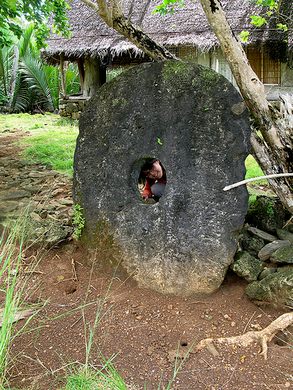Rai Stones
Giant money stones of Yap.
Human societies tend to assign the value to objects based on, among other things, scarcity. This certainly applies in the case of the giant money stones of Yap. There are no sources of limestone on the island of Yap, and one can only imagine the effort needed to transport a 9000-pound stone “coin” using canoes and rafts over hundreds of miles of open ocean.
According to local lore, some 500 to 600 years ago, a man called Anagumang led the expedition from his native island of Yap to the distant island of Palau, 300 miles away. Men of Yap were immediately baffled by Palau’s abundant sources of limestone. Natives of Palau permitted the men of Yap to quarry the rock in exchange for goods and services, establishing an unusual economic exchange between the two islands. Though novelty items at first, these stones soon took on the role of proper currency on Yap. First, stones were carved into the shapes of fish, but later, the slightly more practical disc shape was adopted. The stone remained the chief currency until the 20th century.
As with any currency, Rai stones attracted speculators. David Dean O’Keefe, an Irish-born American sailor and adventurer, started producing Rai stones in large quantities using modern tools imported from Hong Kong. Needless to say this practice devalued the currency, proving that even rock solid money is not immune to inflation.
Today, Rai stones can be seen at the Oceanic Culture Museum in Okinawa, as well as at the Smithsonian Museum of Natural History in Washington D.C.
Know Before You Go
United Airlines is the only airline to service Yap twice a week on Tuesdays and Saturdays from Guam. A small, national carrier, Caroline Islands Air, flies between Yap and Palau once a week or by charter. To visit a Stone Money Bank or any other sites in Yap, visitors must to go with a guide who will get the permission of the chief beforehand. All land in Yap is privately owned and visitors are not allowed to wander alone.
























Follow us on Twitter to get the latest on the world's hidden wonders.
Like us on Facebook to get the latest on the world's hidden wonders.
Follow us on Twitter Like us on Facebook